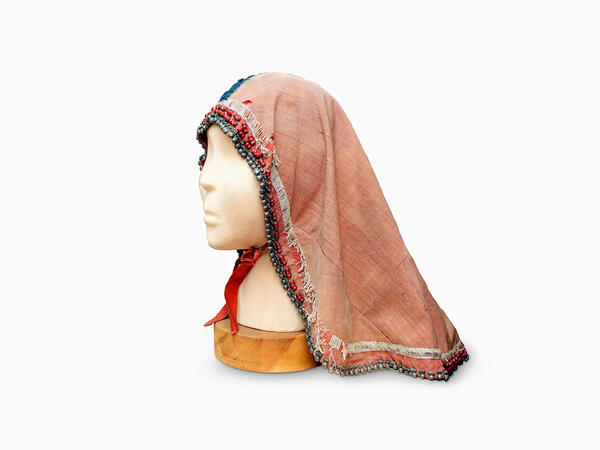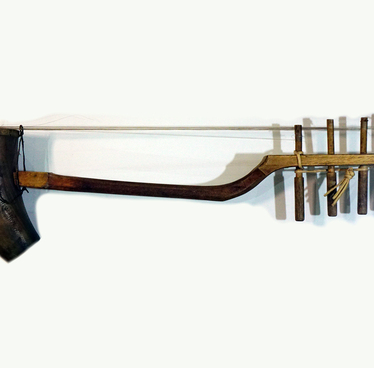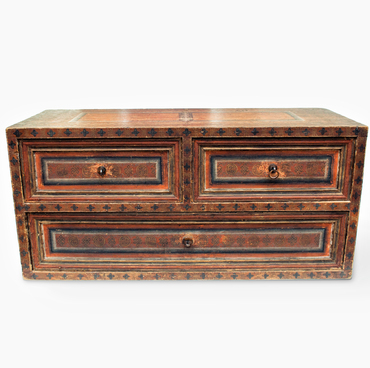Each stage of a Tuvan traditional wedding was accompanied by ancient rituals, from the betrothment to the bride’s moving to groom’s place and the wedding feast.
The brides sewed two special headdresses for the feast — dumaalai and bashtangy. Dumaalai was made of a four-cornered piece of silk or cotton cloth, two meters by one and a half meters. Along one edge of it, an oval piece of fabric was sewn to put it on the head, and a triangle was attached to the front part, which covered the bride’s forehead up to the eyebrows. Free edges were decorated with pendants of beads, coins, small shells, or embroidered with braid and fringe of pink and orange beads.
The second cape, bashtangy, was blind. The lined cloth covered the head, part of the face, shoulders, and back of the bride. The edges of the headdress were trimmed with a narrow border of small molded plaques. Depending on the wealth of the owner they could be silver, copper, bronze, or even lead.
Both headdresses were obligatory elements of the bride’s costume. In the camp of the future husband on her wedding day, the future wife covered her head with both capes: first, she put a dumaalai on and on top of it — a bashtangy. The second cape had no sharp corners, and a border of lead plaques made the edges of the silk fabric heavy enough for the bride to wear the bashtangy comfortably even in windy weather.
In some areas of Tuva, bashtangy was not worn at all. Soviet and Russian ethnographer Leonid Potapov in his works described Mongun-Taigin wedding ceremonies and never mentioned a closed headdress. They probably wore only a dumaalai.
After the wedding, women wore bashtangy also as an everyday cloak. Most likely, such headdress was not embroidered with plaques.
Lavishly decorated bashtangys were kept and passed down as a sign of wealth. The scholar-anthropologist, ethnographer, and writer Feliks Kon wrote in his diary about such valuable women headdresses:
The brides sewed two special headdresses for the feast — dumaalai and bashtangy. Dumaalai was made of a four-cornered piece of silk or cotton cloth, two meters by one and a half meters. Along one edge of it, an oval piece of fabric was sewn to put it on the head, and a triangle was attached to the front part, which covered the bride’s forehead up to the eyebrows. Free edges were decorated with pendants of beads, coins, small shells, or embroidered with braid and fringe of pink and orange beads.
The second cape, bashtangy, was blind. The lined cloth covered the head, part of the face, shoulders, and back of the bride. The edges of the headdress were trimmed with a narrow border of small molded plaques. Depending on the wealth of the owner they could be silver, copper, bronze, or even lead.
Both headdresses were obligatory elements of the bride’s costume. In the camp of the future husband on her wedding day, the future wife covered her head with both capes: first, she put a dumaalai on and on top of it — a bashtangy. The second cape had no sharp corners, and a border of lead plaques made the edges of the silk fabric heavy enough for the bride to wear the bashtangy comfortably even in windy weather.
In some areas of Tuva, bashtangy was not worn at all. Soviet and Russian ethnographer Leonid Potapov in his works described Mongun-Taigin wedding ceremonies and never mentioned a closed headdress. They probably wore only a dumaalai.
After the wedding, women wore bashtangy also as an everyday cloak. Most likely, such headdress was not embroidered with plaques.
Lavishly decorated bashtangys were kept and passed down as a sign of wealth. The scholar-anthropologist, ethnographer, and writer Feliks Kon wrote in his diary about such valuable women headdresses:



